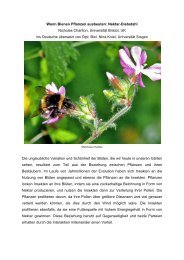PhDâ€theses - Ethologische Gesellschaft
PhDâ€theses - Ethologische Gesellschaft
PhDâ€theses - Ethologische Gesellschaft
You also want an ePaper? Increase the reach of your titles
YUMPU automatically turns print PDFs into web optimized ePapers that Google loves.
Research Update<br />
THE INFLUENCE OF SOCIAL INTERACTION BETWEEN MALE CAVIES AND JUVENILE FEMALE CAVIES<br />
(CAVIA APEREA) AND OF MALE ODORS ON THE MATURATION OF FEMALES<br />
Antje Lembke<br />
antje.lembke@gmx.de<br />
Masters Thesis, supervised by Prof. Dr. Fritz Trillmich, Department of Animal Behavior, and Prof. Dr.<br />
C. Müller, Dept. Chemical Ecology, University of Bielefeld<br />
This study targeted the topic of male influence on the timing of female maturation. The<br />
timing of female maturation is a crucial factor in the life history, especially of small, short<br />
lived mammals. In mice the male influence is well known as the ‘Vandenberg effect’, elicited<br />
by male urinary proteins. In the precocial caviomorph, Cavia aperea the male effect is not<br />
elicited by metabolites in urine. The mechanism behind this effect is still unknown. I tested<br />
the hypothesis that male behavior and male odor contribute to the acceleration of puberty<br />
in females.<br />
In the behavioral experiment, the female onset of fertility was examined. A pair of<br />
females was housed either next to castrates or next to a male, separated by wire mesh. One<br />
of the two females was put into contact with the male or castrate every four days for one<br />
hour. During this time the behavior was recorded. Females housed next to males matured<br />
significantly earlier than females housed next to castrates. The physical contact did not make<br />
a difference in the onset of estrus in the females. Males and castrates did not differ in any of<br />
the behaviors towards females recorded and no significant correlation was found in the<br />
overall activity of males and castrates with the onset of estrus in the females.<br />
To investigate olfactory stimuli, samples of perineal secretion were collected and<br />
analyzed by gas‐chromatography and mass‐spectrometry (GCMS). The spectra of males and<br />
castrates differed significantly. Various peaks were found in male perineal gland secretion<br />
only, but no metabolites were found exclusively in castrates. The number of peaks found in<br />
the male or castrate secretion was correlated with the onset of fertility of the corresponding<br />
female in contact. The results of my experiments suggest that the difference in perineal<br />
gland scent between fertile males and castrates could account for the difference in the<br />
timing of puberty in female cavies. Further characterization of the active substances is<br />
needed.<br />
16



